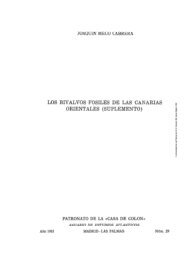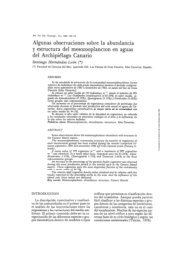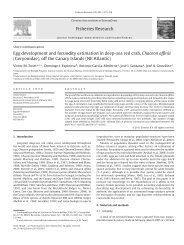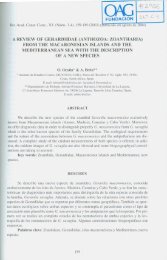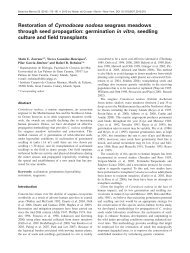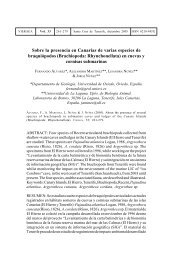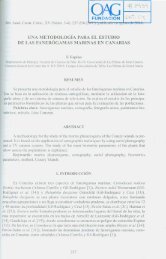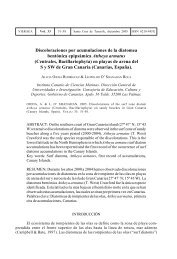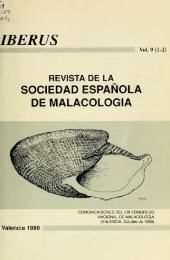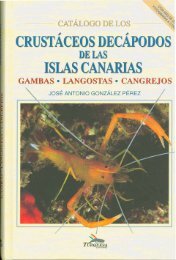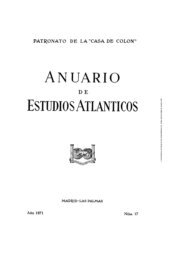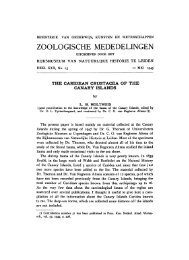of the madeira and selvagens archipelagos - redmic
of the madeira and selvagens archipelagos - redmic
of the madeira and selvagens archipelagos - redmic
You also want an ePaper? Increase the reach of your titles
YUMPU automatically turns print PDFs into web optimized ePapers that Google loves.
3. Existem várias limitações no uso dos modelos preditivos<br />
de distribuição (discutidos neste capítulo), entre as quais,<br />
a incerteza nas fontes de informação e a impossibilidade<br />
de ter em conta variáveis ou processos históricos que<br />
actuam à escala local.<br />
4. Apesar das limitações, os modelos preditivos contribuem<br />
para entender os padrões de distribuição das espécies e<br />
ajudam a localizar novas áreas onde se deve fazer amostragem.<br />
Uma utilização cautelosa destas técnicas pode<br />
ajudar a melhorar o nosso conhecimento acerca de taxa<br />
pouco estudados.<br />
1. Introdução<br />
A extinção de espécies é uma realidade inquestionável<br />
(Pimm et al. 1995; Lawton & May 1995; Dye & Tuggle<br />
1998; Chapin et al. 2000; Biber 2002; Dunn 2005). As estimativas<br />
mais conservadoras prevêem que todas as espécies<br />
estarão extintas dentro de alguns séculos (Stork<br />
1997; Pimm & Raven 2000). O ritmo de extinção maciça é<br />
tão elevado que os cientistas crêem que estamos perante<br />
uma crise de biodiversidade (Chapin et al. 2000). A situação<br />
é particularmente preocupante para taxa como os<br />
insectos, cuja hiper -diversidade impede que se consiga o<br />
conhecimento necessário em tempo útil para proteger essas<br />
espécies (Hammond 1994; Dunn 2005). As alterações<br />
na biodiversidade não são facilmente reversíveis e alteram<br />
dramaticamente o funcionamento dos ecossistemas, com<br />
consequências sociais e económicas marcantes (Chapin et<br />
al. 2000; Balmford & Bond 2005; Mace et al. 2005; Wallace<br />
2007; http://www.millenniumassessment.org/). Como referiu<br />
Edward O. Wilson, galardoado com um prémio Crafoord<br />
(o equivalente aos prémios Nobel em ecologia e evolução):<br />
“Não consigo pensar num problema científico [a extinção]<br />
de maior importância e urgência para a humanidade” (Wilson<br />
2001, p. 242).<br />
Para preservar a biodiversidade, é necessário conhecer<br />
a distribuição (Dobson et al. 1997; Howard et al. 1998; van<br />
Jaarsveld et al. 1998; Araújo & Williams 2000) e a abundância<br />
(Gaston et al. 1997; Gaston & Blackburn 2000) das<br />
espécies. Para além disso, é também necessário compreender<br />
as causas dos padrões de distribuição actuais<br />
das diversas formas de vida. Isto permitirá a implementação<br />
de medidas de conservação com base numa sólida<br />
compreensão do fenómeno da biodiversidade e da sua<br />
crise actual. A distribuição dos organismos é, no entanto,<br />
um fenómeno complexo e dinâmico, determinado por<br />
um gr<strong>and</strong>e número de processos, cuja contribuição varia<br />
consoante os gradientes geográficos e a escala espacial<br />
de análise. Para além disso, a informação relativa à distribuição<br />
de espécies é muitas vezes escassa, o que produz<br />
uma imagem enviesada e fragmentada (limitada no<br />
espaço e no tempo) da “verdadeira” distribuição da maior<br />
parte das espécies. Existe, todavia, alguma informação<br />
disponível a diferentes escalas espaciais e temporais para<br />
algumas espécies ameaçadas. No entanto, frequentemente,<br />
quanto mais detalhada for a resolução, maior é o<br />
28<br />
4. In spite <strong>of</strong> <strong>the</strong>ir limitations, distribution models provide<br />
useful insights into <strong>the</strong> distribution patterns <strong>of</strong> <strong>the</strong> species<br />
<strong>and</strong> help to locate new areas to survey. A cautionary<br />
use <strong>of</strong> <strong>the</strong>se techniques may help to improve our underst<strong>and</strong>ing<br />
<strong>of</strong> relatively poorly known taxa.<br />
1. Introduction<br />
Species extinctions are an undeniable reality (Pimm et<br />
al. 1995; Lawton & May 1995; Dye & Tuggle 1998; Chapin<br />
et al. 2000; Biber 2002; Dunn 2005). The most conservative<br />
estimates foresee all species being lost in a few centuries<br />
(Stork 1997; Pimm & Raven 2000). The speed <strong>of</strong> massive<br />
extinction is so high that most scientists agree that we are<br />
facing an enormous biodiversity crisis (Chapin et al. 2000).<br />
The situation is especially worrisome for hyperdiverse taxa,<br />
such as insects; <strong>the</strong>ir overwhelming diversity makes it impossible<br />
to underst<strong>and</strong> everything we need for <strong>the</strong>ir protection<br />
before it is too late (Hammond 1994; Dunn 2005).<br />
Changes in biodiversity are not easily reversible <strong>and</strong> alter<br />
ecosystem functioning dramatically, with important social<br />
<strong>and</strong> economic consequences (Chapin et al. 2000; Balmford<br />
& Bond 2005; Mace et al. 2005; Wallace 2007; http://www.<br />
millenniumassessment.org/). In <strong>the</strong> words <strong>of</strong> <strong>the</strong> Crafoord<br />
Prize winner (<strong>the</strong> equivalent to <strong>the</strong> Nobel Prize in ecology<br />
<strong>and</strong> evolution) Edward O. Wilson: “I cannot imagine a scientific<br />
problem <strong>of</strong> greater immediate importance for humanity”<br />
(Wilson 2001, p. 242).<br />
Preserving biodiversity requires knowledge <strong>of</strong> <strong>the</strong> distribution<br />
(Dobson et al. 1997; Howard et al. 1998; van Jaarsveld<br />
et al. 1998; Araújo & Williams 2000) <strong>and</strong> abundance<br />
(Gaston et al. 1997; Gaston & Blackburn 2000) <strong>of</strong> species.<br />
Fur<strong>the</strong>rmore, it is also necessary to underst<strong>and</strong> <strong>the</strong> causes<br />
<strong>of</strong> <strong>the</strong> current patterns <strong>of</strong> distribution <strong>of</strong> <strong>the</strong> diverse life<br />
forms. This will allow nature conservation to be based on<br />
a solid comprehension <strong>of</strong> both <strong>the</strong> phenomenon <strong>of</strong> biodiversity<br />
<strong>and</strong> its current crisis. However, <strong>the</strong> distribution<br />
<strong>of</strong> organisms is a complex <strong>and</strong> dynamic phenomenon determined<br />
by numerous processes, <strong>the</strong> relevance <strong>of</strong> which<br />
varies along geographical gradients <strong>and</strong> according to <strong>the</strong><br />
spatial scale <strong>of</strong> analysis. In addition, distributional information<br />
is frequently scarce, commonly <strong>of</strong>fering a biased <strong>and</strong><br />
fragmentary picture <strong>of</strong> <strong>the</strong> “true” distribution over a limited<br />
spatial <strong>and</strong> temporal snapshot for almost all species.<br />
Although for some endangered flag -species distributional<br />
information can be available at some scales, <strong>the</strong> more detailed<br />
<strong>the</strong> resolution, <strong>the</strong> greater <strong>the</strong> number <strong>of</strong> gaps in <strong>the</strong><br />
maps (Hurlbert & Jetz 2007). In <strong>the</strong> same way, <strong>the</strong> smaller<br />
in size <strong>the</strong> species, <strong>the</strong> less is known about its distribution.<br />
So, considering that insects are more than 50% <strong>of</strong><br />
all known living organisms on earth (Wilson 2001) – <strong>and</strong>



